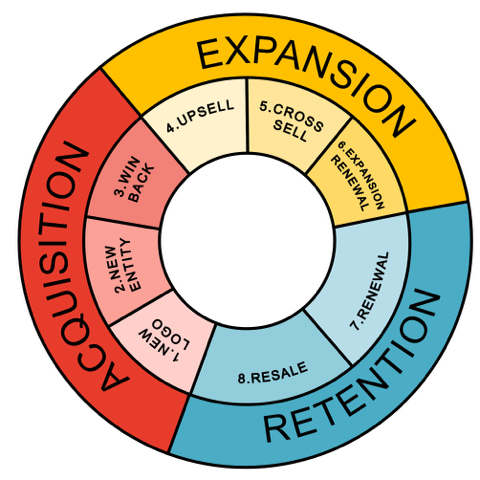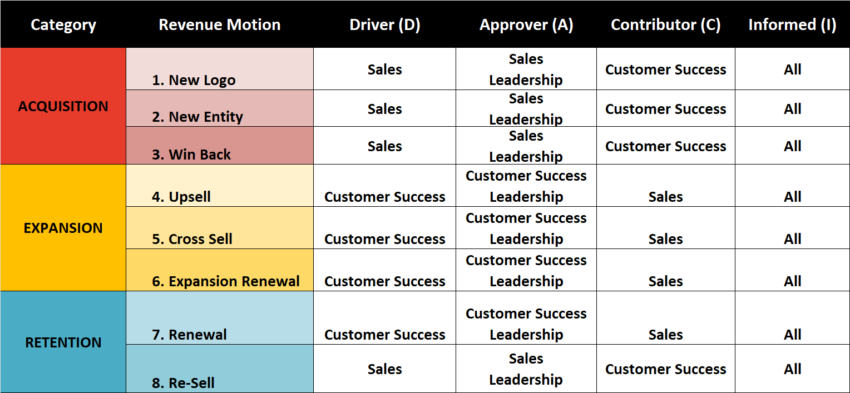Revenue Objectives of Customer Success
The Importance of Revenue Responsibility Alignment in GTM Orchestration
Optimal go-to-market (GTM) orchestration requires the alignment of roles and revenue responsibilities within and across departments. This coordination is more complex with SaaS companies as a subscription model has created additional revenue motions (scenarios) and heightened the importance of the Customer Success department.
In many SaaS businesses, there is organizational stress because of informal, incomplete, or incorrect revenue policies. Unfortunately, this is most visible with the interplay between Sales and Customer Success, which frequently turns into a tension-filled battleground.
It is essential that GTM leadership eliminates such tension and never leaves employees ill-equipped or poorly motivated to excel in their positions. This is important for overall business success for several reasons:
- Smooth GTM process (aka Let’s not look stupid in front of customers!)
- Talent management (aka Let’s hire and retain the right staff!)
- Growth performance (aka Let’s delight customers AND grow the business!)
Guiding Principles for Defining and Implementing an Effective Revenue Responsibility Policy
The following are guiding principles to successfully define and implement the best revenue responsibility policy:
Guiding Principle #1
Consider all relevant forms of SaaS revenue motions resulting in contractual commitments. See Figure 1. Avoid the rookie mistake of assuming there are only three motions: new business, renewal, and expansion. Failure to consider each scenario can lead to missed revenue opportunities and internal chaos.
Guiding Principle #2
Move beyond a simplistic owner/non-owner decision method and embrace a DACI-like structure that promotes collaboration rather than isolation. The goal is to have more people thinking about growth, not less.
Guiding Principle #3
Utilize your CRM system to measure and track the various revenue motions (aka deal types). Gain greater visibility into the volume and win ratio of each motion, enabling better decisioning and optimization with regards to revenue responsibilities.
Guiding Principle #4
Establish a cross-functional SWAT team led by key Sales and Customer Success leaders to define and refine the revenue responsibility policy. Engage in discussions guided by critical decision factors for each revenue motion. Consider inclusion of other functions as decisions may impact legacy structures like incentive plans.
Guiding Principle #5
Allow for an exception process within the broader policy but ensure that the review process is clear and restricts exception requests to a minimum.
SaaS Revenue Motions for Customer Success Consideration
Per Guiding Principle #1, it is crucial to consider all relevant forms of SaaS revenue motions across the customer journey. These motions can be mapped to the primary activities of Acquisition, Expansion, and Retention. I recommend reviewing at least the following eight primary revenue motions:

To decide upon the revenue responsibilities of Customer Success, let’s quickly define the possible motions and highlight typical ownership.
- New Logo: Acquisition of new customers (new brands, new logos, etc.) where there is no existing relationship or connection. Traditional, textbook definition of a Sales responsibility.
- New Entity: Acquisition of new “sub/child accounts” (divisions, line-of-business, departments, regions, etc.) that have a corporation connection to an existing customer. New stakeholders with a new decision but within a parent account family. Since requires building new relationships, biases towards Sales responsibility.
- Win-Back: Re-acquisition of previously lost/churned accounts. Traditional, textbook definition of a Sales responsibility. May be a distraction for Customer Success.
- Upsell: Expansion of current customer commitments to currently purchased products. More of the same product. This should be a core responsibility of Customer Success as if one can’t properly upsell, then can one properly drive the renewal?
- Cross Sell: Expansion of current customer commitments with purchase of new products. More business but different products. This could be a core responsibility of Customer Success
- Expansion Renewal: Expansion of current customer commitment, either by upsell and/or cross sell, to include renewal to co-term/unify relationship. A common use case is to use expansion to justify an early renewal. This could be a core responsibility of Customer Success.
- Renewal: Extension of current customer commitment. Traditional textbook definition of Customer Success responsibility.
- Re-Sell: Extension of current customer commitment that requires a “back to the start” approach. Efforts require a process that mimics New Logo motion either because of new stakeholders, unrealized impact, flawed adoption, merger/acquisition, or budget threats. This typically ends up being a responsibility of Customer Success – but more as an accidental consequence of renewal ownership.
Key Decision Factors for Determining Customer Success Role in Revenue Motions When making purposeful decisions regarding the role of Customer Success in the primary revenue motions, it is important to at least consider the following key decision factors:
- Customer Success Commercial Skillset. It is important to assess the existing (or future) skillset of the Customer Success team in terms of commercial acumen, business knowledge, and sales expertise. Determine their comfort level and capability in establishing new relationships and driving growth.
- Market Complexity. Evaluate the market complexity of your solution based on factors such as the business segment, average deal size, category maturity, or buyer decision complexity. More complex solutions often require advanced commercial skills to navigate the revenue motions effectively.
- Expansion Growth Opportunity. Consider the growth opportunities associated with upsells and cross-sells within your business. If your organization operates with a heavy land and expand strategy and offers multiple expansion possibilities, it may necessitate a higher level of commercial expertise.
The following table provides guidelines for decision-making based on the critical decision factors:
| Decision Factor | Tips & Hints |
| CS Commercial Orientation | The more sales-savviness of the Customer Success team, the more confident staff can be in taking on some Acquisition responsibilities (New Entity, Win-Back). Need to consider Market Complexity factor as well. If Customer Success is not hyper commercial-oriented, then consider Customer Success for Expansion & Renewal responsibilities. |
| Market Complexity | The simpler the market landscape, the easier it is for Customer Success to take ownership of Expansion responsibilities (Upsell, Cross-sell, Expansion Renewal). Need to consider Expansion Opportunity factor as well. If complex, then may not be appropriate for Customer Success to lead Expansion responsibilities. Customer Success to focus on Renewals. |
| Expansion Opportunity | If there is not a significant Expansion Opportunity, it may be appropriate for Customer Success to lead Expansion & Renewal responsibilities for all clients. If there is a significant Expansion Opportunity, that requires specialized attention, then either staff Customer Success appropriately or focus Customer Success on Renewals. |
Please note that other factors may be important to some businesses (e.g. overall budget, salary cap, etc..) and there may be a preferred order to process the factors within the broader decision workflow.
5 Steps to Attain Revenue Clarity for Customer Success
The following are simple steps to achieve revenue clarity for Customer Success:
Step 1: Identify Applicable Revenue Motions
Step 2: Build a DACI-Type Table
Step 3: Assemble the Right Group for Discussion
Step 4: Engage in discussion considering critical decision factors
Step 5: Volia! Achieve Revenue Clarity
By implementing these simple steps, you can establish a clear understanding of Customer Success’ revenue responsibilities, ensuring alignment across teams and promoting effective revenue generation throughout the customer journey.
Revenue Responsibilities for Customer Success: Case Study
SETUP: Customer Success organization is not designed or staffed for aggressive sales pursuit – but the team has solid commercial orientation. The market category is developed, and the average deal size is ~$50k. There is clear persona stakeholder, limited buying committee, and deal transactions are straightforward. Upsells are usage-based and easy to pursue. There are limited cross sells which are direct extensions of the base solution. No viable business case to distract the New Logo Sales team with expansion or hire dedicated Expansion Sales resources. Suggested revenue responsibilities:

Conclusion: Customer Success owns Renewal and Expansion revenue motions. Sales takes the lead on anything that requires heavy “new relationship” pursuit.
Special Considerations for Defining Revenue Responsibilities
In addition to the steps outlined earlier, there are some special considerations that may come into play:
- Segmentation:
The process of defining revenue responsibilities may vary based on different business segments or groups within an organization. For example, Enterprise and SMB segments may have separate sales and customer success teams. In such cases, decisions regarding revenue responsibilities can be tailored to each segment (i.e. separate DACI deliverable for each). For instance, the SMB segment may have limited upsell and cross-sell opportunities, making it more suitable to enable those activities through the Customer Success team.
- Account Management and Renewal Management Extensions:
In this article, our discussion has been with a simple model of the primary departments of sales and customer success. In larger organizations, sub functions within those departments may also come into play. For example, if one designates Sales to own a new logo, new sub account, upsell and cross-sell, one may consider distinct sub-teams for new business sales (Hunter) and expansion sales (Farmer). Another example, if one designates Customer Success to own renewal, upsell and cross-sell, one may consider adding a renewal management sub function within the broader Customer Success department.
Conclusion
A proper revenue responsibility framework is a critical element for organizations seeking to foster revenue growth, drive expansion, and achieve renewal success within the competitive SaaS industry. This framework serves as a guiding principle, ensuring that roles and responsibilities within Sales and Customer Success are clearly defined, well-understood, and effectively aligned. By doing so, organizations can foster a collaborative and cohesive working environment that maximizes revenue potential.
GTM (Go-To-Market) leadership plays a vital role in the successful implementation of this framework. It is their responsibility to ensure that each employee has the necessary tools, resources, and support to excel in their roles and contribute to the organization’s revenue goals. By stepping up and actively driving revenue responsibility clarity, GTM leaders can eliminate any ambiguity or confusion surrounding responsibilities, thereby empowering their teams to deliver exceptional results.
Learn more about mobilizing your ICP throghout the whole GTM from our webinar.
Don’t forget! Discover the top GTM strategies from B2B experts at RevCon: our must-attend annual conference on October 18-19, 2023!